Our family spent the '97 Christmas holidays roaming through Abra and the Ilocos Provinces in Northern Philippines. While there, we visited Vigan, a very interesting city in the Province of Ilocos Sur facing the South China Sea. We found in Vigan a Chinese pottery shop with such an interesting story that I decided to publish it here for the enjoyment of all fellow cybernauts. Some of the photos we took during the trip serve to illustrate my recollections. I wish the story gives you as much pleasure as I had visiting the site and writing about it.
I revisited Vigan in the company of my wife in March of 2007, this time with a digital SLR camera that allowed me to take new vistas of a better quality and to replace old ones having poor resolution as they were taken on film and scanned with rather primitive equipment. I only kept two pictures from the old collection, those of the kiln, I missed taking good ones of this part of the pottery. The page has now more pictures than the old one as I have a much larger collection to select from, 83 pictures of the city and 88 of the pottery to be exact.

The city
Vigan is one of the oldest cities
in the Philippines. The old Spanish settlement in Vigan was called Ciudad
Fernandina. The name became Nueva
Segovia when the see of the diocese of the same name was transferred
from Lal-Lo in Cagayan Valley to Ciudad Fernandina in the XVIII century.
Vigan became an important political, military, cultural, and religious
center. It still preserves pavements of cobbled stones in streets between
some two dozen blocks of colonial homes typical of the place.
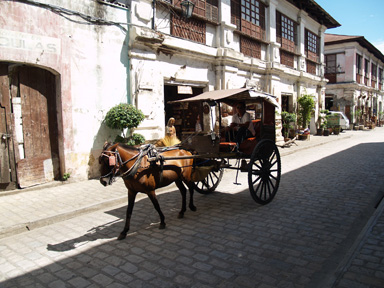
These two-story old homes follow a
common architectural plan with ground floors built of stone or bricks,
a backyard with abundant vegetation and an occasional water well, and an
interior hardwood grand staircase leading to the upper floor done also
in hardwood, if not stone. The ground floor has a large wooden gate and
is used as storage and shed, it has no windows. The second floor opens
on the four sides with sliding windows made of wooden frames that hold
flat, semi-transparent "capiz" (a tropical scallop) shells. In old times,
roofs were thatched with 'cogon', a tough tall grass whose only use seems
to be roofing. Today most roofs, even on the colonial homes, are of tin
like in most of the rest of the country. Many of the old homes are still
lived in, others are used as curio shops or offices. A few owned by old
prominet families have been converted to museums of local interest.
The only vehicles allowed on the cobbled streets are 'carretelas': one-pony, two-seat cabrioles on spoked wooden wheels with steel ties. The old homes, the unhurried pedestrians, and the horse-drawn traffic make for a very pleasant old-world ambiance not very common in other Philippine towns today.
For a sort description-cum-history
of Vigan click
Vigan:
the city
The shop
Vigan has an ancient pottery shop
established by a family of Chinese immigrants about two centuries ago.
It is known today by its commercial name RJ
Jars. Practically nothing has changed ever since in the establishment:
ownership was kept in the same family for generations until today, and
the shop still produces the same every-day utilitarian pieces with a technology
that stayed the same since it was imported from China. We learned all the
details and history of the shop operations from the present owner, a very
pleasant middle-aged ethnic Chinese lady, and very patient too, for we
really fielded a lot of questions. I was under the mistaken notion that
her name was Patricia Amistad, a name given to me by an anonimous email
correspondent shortly after I published the web page. I learned now, and
stand corrected, from the same lady that she is really Teresita Alcid,
proprietess of RJ Jars in Vigan.
The clay vessel whose manufacture is shown in the accompanying pictures was made outside of the shop's normal production schedule. The day we visited the shop, the workers were removing finished products from the kiln and nobody was working on clay. Then we started asking questions from Mam Teresita on the manufacturing process. She saw so much curiosity in our questions and was so accommodating that she called one of her potters and asked him to do a sample so we could appreciate the details of the craft. This allowed us to take pictures, some of which illustrate the story on this page.
 The
shop, with its tools and fixtures, is a rather rural and primitive affair.
One finds in it none of the amenities of a modern shop except for the presence
of a few electric bulbs. It is a large rectangular structure with low brick
walls that do not reach the tin roof on timbers. The floor is earth hardened
by two centuries of treading on it. The craftsman in the picture is at
work near one end of the shop which is open to the outside. The brick wall
in front of him does not reach the roof and against the low wall is his
work bench: a wooden board resting on a stone and mortar foot. The kiln
is built across the other end of the shop, far to the left of the potter.
The kiln is a 30-meter long clay-and-brick structure semicircular in section
resting on a natural incline of the terrain with a tall entrance at one
end and a fire-feeding opening at the other. The kiln floor is also earthen.
The potter works seated on a rough bench.
The
shop, with its tools and fixtures, is a rather rural and primitive affair.
One finds in it none of the amenities of a modern shop except for the presence
of a few electric bulbs. It is a large rectangular structure with low brick
walls that do not reach the tin roof on timbers. The floor is earth hardened
by two centuries of treading on it. The craftsman in the picture is at
work near one end of the shop which is open to the outside. The brick wall
in front of him does not reach the roof and against the low wall is his
work bench: a wooden board resting on a stone and mortar foot. The kiln
is built across the other end of the shop, far to the left of the potter.
The kiln is a 30-meter long clay-and-brick structure semicircular in section
resting on a natural incline of the terrain with a tall entrance at one
end and a fire-feeding opening at the other. The kiln floor is also earthen.
The potter works seated on a rough bench.
Working with
clay
From beginning to end, all the steps
in the process of pottery production are done according to skills passed
from parents to children and perfected through long years of practice without
benefit of written manuals, time-and-motion studies or established quality
control procedures.
Making a clay vessel begins with kneading the wet clay with the hands to attain the proper humidity and consistency. Wet clay for the day's work is kept in mounds in the shade covered by sack cloth to keep dampness. The clay for the shop is procured in the vicinity and is of a quality that pieces produced from it have a deep dark brown, almost burnt sheen.
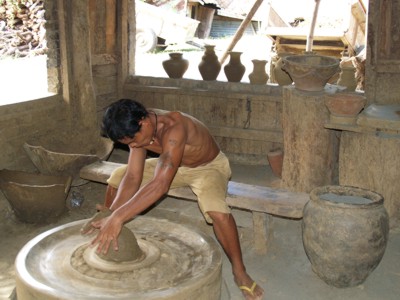 |
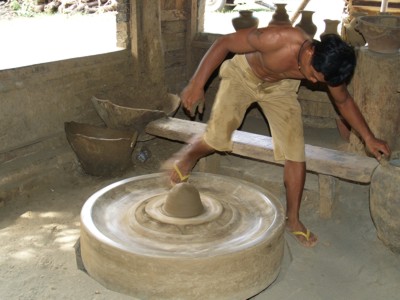 |
The potter's
wheel
Next comes the modeling process. The
potter carefully positions the clay lump he just worked on the center of
the potter's wheel and starts turning it.
The wheel is rather large and very heavy as can be seen in the pictures.
| In olden times, the wheel was wooden, today it is made of concrete. The wheel should be heavy enough to develop sufficient momentum to turn unaided for six or seven minutes. | 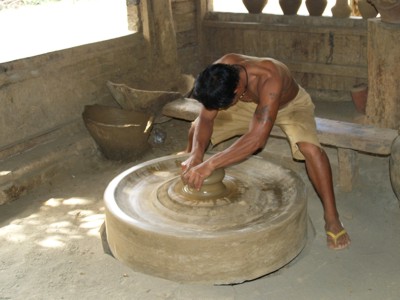 |
 |
| To achieve this, the potter pushes with his foot, steadily increasing the wheel speed for one or two minutes. He keeps balance by holding on to something, sometimes a loop of rope above his head. | 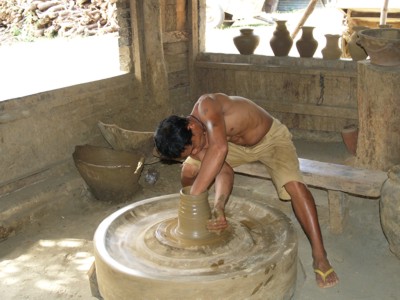 |
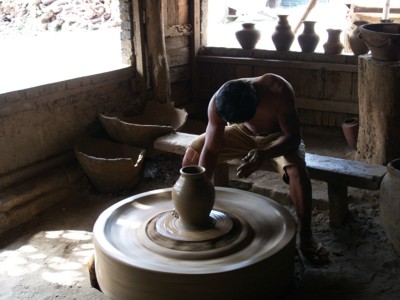 |
| When enough speed is reached, the potter works the clay lump shaping it with his hands, aided by the rotation of the wheel to achieve symmetry. He uses one hand to mold the exterior while the other works the vessel interior, both hands working in coordination with smooth movements. | 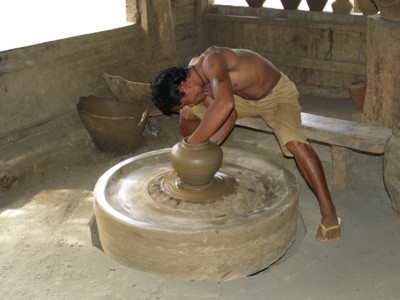
It took him some six minutes to mold the vessel in the picture, about a foot tall. He had to finish it before the wheel stopped or the vase would have a poor consistency and would break or misshape while firing in the kiln. |

Remarkable craftsmanship, and a good measure of concentration, muscular strength and accuracy, are needed to attain a quick finish with the quality and evident elegant proportions seen in the vessel fashioned in front of our eyes. |
More pottery photos (JR Perdigon) here
| Watch video: |
|
|